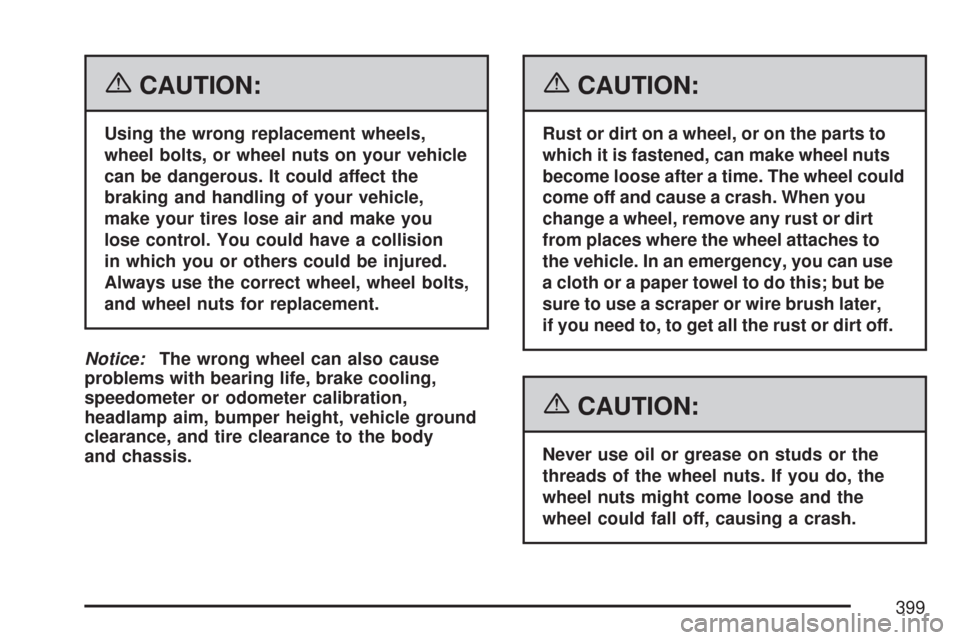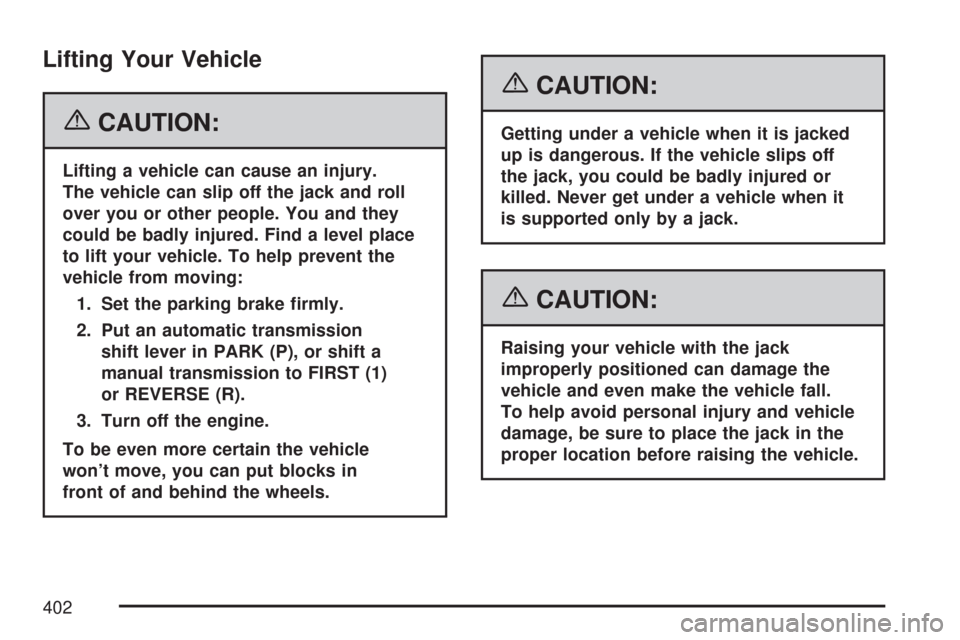Page 396 of 488

Different Size Tires and Wheels
If you add wheels or tires that are a different size
than your original equipment wheels and tires,
this may affect the way your vehicle performs,
including its braking, ride and handling
characteristics, stability, and resistance to
rollover. Additionally, if your vehicle has electronic
systems such as, anti-lock brakes, traction
control, and electronic stability control, the
performance of these systems can be affected.
{CAUTION:
If you add different sized wheels, your
vehicle may not provide an acceptable
level of performance and safety if tires
not recommended for those wheels are
selected. You may increase the chance
that you will crash and suffer serious
injury. Only use GM speci�c wheel and
tire systems developed for your vehicle,
and have them properly installed by a
GM certi�ed technician.SeeBuying New Tires on page 394and
Accessories and Modi�cations on page 319
for additional information.
Uniform Tire Quality Grading
Quality grades can be found where applicable
on the tire sidewall between tread shoulder
and maximum section width. For example:
Treadwear 200 Traction AA Temperature A
The following information relates to the system
developed by the United States National
Highway Traffic Safety Administration (NHTSA),
which grades tires by treadwear, traction, and
temperature performance. This applies only
to vehicles sold in the United States. The grades
are molded on the sidewalls of most passenger
car tires. The Uniform Tire Quality Grading
(UTQG) system does not apply to deep tread,
winter-type snow tires, space-saver, or temporary
use spare tires, tires with nominal rim diameters
of 10 to 12 inches (25 to 30 cm), or to some
limited-production tires.
396
Page 399 of 488

{CAUTION:
Using the wrong replacement wheels,
wheel bolts, or wheel nuts on your vehicle
can be dangerous. It could affect the
braking and handling of your vehicle,
make your tires lose air and make you
lose control. You could have a collision
in which you or others could be injured.
Always use the correct wheel, wheel bolts,
and wheel nuts for replacement.
Notice:The wrong wheel can also cause
problems with bearing life, brake cooling,
speedometer or odometer calibration,
headlamp aim, bumper height, vehicle ground
clearance, and tire clearance to the body
and chassis.
{CAUTION:
Rust or dirt on a wheel, or on the parts to
which it is fastened, can make wheel nuts
become loose after a time. The wheel could
come off and cause a crash. When you
change a wheel, remove any rust or dirt
from places where the wheel attaches to
the vehicle. In an emergency, you can use
a cloth or a paper towel to do this; but be
sure to use a scraper or wire brush later,
if you need to, to get all the rust or dirt off.
{CAUTION:
Never use oil or grease on studs or the
threads of the wheel nuts. If you do, the
wheel nuts might come loose and the
wheel could fall off, causing a crash.
399
Page 400 of 488
Tightening Wheel Lug Nuts
{CAUTION:
Incorrect wheel nuts or improperly
tightened wheel nuts can cause the wheel
to become loose and even come off.
This could lead to a crash. Be sure to
use the correct wheel nuts. If you have
to replace them, be sure to get new GM
original equipment wheel nuts.
Notice:Improperly tightened wheel nuts can
lead to brake pulsation and rotor damage.
To avoid expensive brake repairs, evenly
tighten the wheel nuts in the proper sequence
and to the proper torque speci�cation.Tighten the wheel
lug nuts �rmly in a
crisscross sequence
as shown.
Used Replacement Wheels
{CAUTION:
Putting a used wheel on your vehicle is
dangerous. You cannot know how it has
been used or how far it has been driven.
It could fail suddenly and cause a crash.
If you have to replace a wheel, use a
new GM original equipment wheel.
400
Page 401 of 488
Tire Chains
{CAUTION:
Do not use tire chains. There is not
enough clearance. Tire chains used on
a vehicle without the proper amount
of clearance can cause damage to the
brakes, suspension, or other vehicle
parts. The area damaged by the tire
chains could cause you to lose control
of your vehicle and you or others
may be injured in a crash.
CAUTION: (Continued)
CAUTION: (Continued)
Use another type of traction device
only if its manufacturer recommends it
for use on your vehicle and tire size
combination and road conditions.
Follow that manufacturer’s instructions.
To help avoid damage to your vehicle,
drive slowly, re-adjust or remove the
device if it is contacting your vehicle,
and do not spin your wheels. If you
do �nd traction devices that will �t,
install them on the rear tires.
401
Page 402 of 488

Lifting Your Vehicle
{CAUTION:
Lifting a vehicle can cause an injury.
The vehicle can slip off the jack and roll
over you or other people. You and they
could be badly injured. Find a level place
to lift your vehicle. To help prevent the
vehicle from moving:
1. Set the parking brake �rmly.
2. Put an automatic transmission
shift lever in PARK (P), or shift a
manual transmission to FIRST (1)
or REVERSE (R).
3. Turn off the engine.
To be even more certain the vehicle
won’t move, you can put blocks in
front of and behind the wheels.
{CAUTION:
Getting under a vehicle when it is jacked
up is dangerous. If the vehicle slips off
the jack, you could be badly injured or
killed. Never get under a vehicle when it
is supported only by a jack.
{CAUTION:
Raising your vehicle with the jack
improperly positioned can damage the
vehicle and even make the vehicle fall.
To help avoid personal injury and vehicle
damage, be sure to place the jack in the
proper location before raising the vehicle.
402
Page 421 of 488

Fuses Usage
SPARE Spare Fuse
SPARE Spare Fuse
SPARE Spare Fuse
SPARE Spare Fuse
TPA Tonneau Pulldown Actuator
ONSTAR OnStar
®
DRIV DR
SWTCHDriver Door Switch
TELE SWTCH/
MSMTelescope Switch,
Memory Seat Module
IGN SWTCH/
INTR SNSRIgnition Switch, Intrusion Sensor
BCK/UP LAMP Reverse Lamps
REVERSE
LAMPSReverse Lamps
Blank Not Used
STOP LAMP Stop Lamp
BTSI SOL/
STR WHL LCKBrake Transmission Shift Interlock,
Steering Wheel Column Lock
BLANK Not Used
Fuses Usage
RDO/S-BAND/
VICSRadio, S-Band, VICS
REAR FOG/
ALDL/TOP
SWTCHRear Fog Lamp, Assembly Line
Diagnostic Link Connector,
Convertible Top Switch
GM LAN
RUN/CRNKGM LAN Devices
ISRVM/ HVACElectric Inside Rearview Mirror,
Heating Ventilation, Air Conditioning
CRUISE
SWTCHCruise Control Switch
TONNEAU
RELSETonneau Release
RUN CRNK Run/Crank Relay
HTD SEAT/
WPR RLYHeated Seat, Wiper Relays
ECM Engine Control Module
SDM/AOS
SWTCH
AIRBAGSensing and Diagnostic Module,
Automatic Occupant Sensing
Module, Airbag
CLSTR/HUD Cluster, Heads-Up Display
HVAC/
PWR SNDHeating, Ventilation/Air Conditioning,
Power Sounder
421
Page 423 of 488
Fuse Usage
1Transmission Control Module/
Transmission
2 Horn, Alternator SenseFuse Usage
3Anti-lock Brakes/Real Time
Damping
4 Wiper
423
Page 424 of 488
Fuse Usage
5 Stoplamps/Back-Up Lamps
6 02 Sensor
7 Battery Main 5
8 Park Lamps
9Powertrain Relay Input/
Electronic Throttle Control
10 Manual Transmission Solenoids
11Engine Control Module/
Transmission Control Module/
Easy Key Module
12 Odd Numbered Fuel Injectors
13Electronic Suspension Control
(Option)
14Canister Purge Solenoid,
Mass Air Flow Sensor
15 Air Conditioner Compressor
16 Even Numbered Fuel Injectors
17 Windshield Washer
18 Headlamp Washer
19Passenger Side Low-Beam
HeadlampFuse Usage
20 Fuel Pump
21 Driver Side Low-Beam Headlamp
22 Front Fog Lamp
23Passenger Side High-Beam
Headlamp
24 Driver Side High-Beam Headlamp
J-Style Fuses Usage
25 Cooling Fan
26 Battery Main 3
27 Anti-lock Brake System
28Heating/Ventilation/
Air Conditioning Blower
29 Battery Main 2
30 Starter
31 Audio Ampli�er
32 Blank
33 Battery Main 1
424